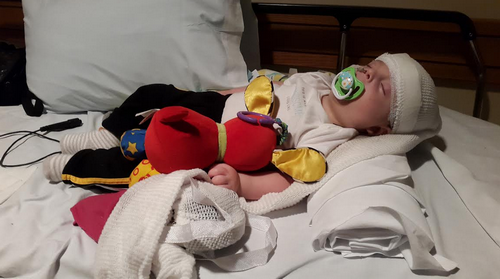Dravet Syndrome
Last reviewed by Dr. Raj MD on January 12th, 2022.
Dravet is a lifelong form of epilepsy. It starts in the first year of life and is called severe myoclonic epilepsy of infancy.
The seizure persists as the child grows older. Aside from seizure, the patient also has developmental delay and abnormal EEG. The first onset of seizure is associated with fever.
The seizure is tonic clonic in nature, which is characterized by jerking movement on one side of the body. On the first five years of life, the patient experiences myoclonic seizure, which is shock-like jerking movement of the muscles. (1, 2)
The first onset of seizure is associated with fever. The succeeding seizures can take place even if the patient has no fever. Other causes of seizures include the following:
- Slight changes in body temperature
- Seizure triggered by flashing lights
- Emotional stress and excitement (2)
Symptoms of Dravet syndrome
- Seizures as described above
- Unsteady gait
- Low motor tone causing painful foot
- Crouched gait in older children and adults
- Susceptibility to infection because the body has less ability to produce antibodies
- Problems of the autonomic nervous system
- Problems with growth and nutrition (3, 4)
Are epileptic seizures hereditary?
Those people suffering from epilepsy are more likely to have a family history of seizure. However, if your parents have epilepsy, it does not necessarily mean that you will automatically have epilepsy. Two out of 100 people develop epilepsy. If your father has epilepsy, you are slightly at risk. On the other hand, if your mother has epilepsy, you are still at risk but the ratio is usually five in 100. (5)

Image 1: A photo of a child experiencing generalized seizures.
Picture Source: seizures.dolyan.com
 Picture 2: An image of a baby who is diagnosed with Dravet syndrome
Picture 2: An image of a baby who is diagnosed with Dravet syndrome
Image Source: lilcuss.files.wordpress.com
What is an epilepsy syndrome?
Epilepsy syndrome is an organized group of seizure sharing the same type, onset, and characteristics. A syndrome is a set of related symptoms that occur together. (4)
What is Doose Syndrome?
Doose syndrome is known as Myoclonic-Astatic Epilepsy (MAE). It is an epilepsy syndrome of early childhood, which is resistant to medication. The exact cause for seizure is unknown. The seizure comes from all over the brain. It is difficult to treat because of its resistance to medication. (4)
How to diagnose Dravet syndrome?
One out of 15,700 infants in the US have Dravet syndrome. About 80% of patient with Dravet syndrome have SCN1A mutation. However, the presence of mutation is not sufficient to diagnose Dravet syndrome.
Dravet syndrome can also be linked with other mutations. Genetic testing is done to thoroughly assess the presence of Dravet syndrome. For genetic testing, a study via epilepsy panel is done, especially in patients who demonstrate the following clinical manifestations:
- Two or more prolonged seizures by the age of 1.
- Two seizures affecting alternate sides of the body.
- Prolonged seizure and hemi-clonic seizure (rhythmic jerking of one side of the body) by the age of 1.
- History of seizure up to 18 months old.
If any of the members of your family has been experiencing seizures or you are suspecting Dravet syndrome, the best thing to do is to consult your neurologist. The doctor will usually use an epilepsy panel to test for SCN1A and other genes commonly linked with epilepsy. (5, 6, 7)
Dravet Syndrome Treatment
To properly and efficiently treat the patient, the disease should be diagnosed at an early age. Dravet syndrome is handled by a multidisciplinary team as it is not only the patient that is addressed, but as well as the immediate family. To treat the seizure, a combination of various drugs is used.
These drugs are not only designed to treat seizures but as well as to prevent potential seizure attack. Preventing seizure helps improve the developmental abilities of the patient as well as decrease the risk of death.
There are medications that should be avoided such as sodium channel blockers. These drugs can aggravate seizure in patients with Dravet syndrome. Examples of sodium channel blockers are phenytoin, carbamazepine, rufinamide. Some medications can increase the frequency of myoclonic seizures such as tiagabine and vigabatrin. (6, 7, 9)
Drug of choice for Dravet syndrome
Dravet syndrome is resistant to treatment. To efficiently minimize seizure episodes, multiple drugs should be used, especially in the first five years of life. The effective drug combination for children with Dravet syndrome includes stiripentol, clobazam, and valproic acid. These drugs are beneficial for controlling refractory generalized tonic clonic seizures. However, they should be given at controlled dose because too high level could lead to toxicity. If the patient showed side effects, the dose is reduced by 30% every week. (10)
Aside from drug therapy, the patient also response positively in ketogenic diet and vagus nerve stimulation. A research on the use of purified form of cannabidiol in children with Dravet syndrome also came out positive.
The treatment plan for children with Dravet syndrome should include seizure response plan. It includes fever management, use of seizure monitors, and emergency management of prolonged seizures. Developmental assessment should start at an early age. The patient should receive holistic care including physical, occupational, social, and speech therapy. (5, 9, 10)
Prognosis and Life expectancy
Dravet syndrome is a serious disease and shouldn’t be taken lightly. Medications are available but does not offer complete seizure control. Other health problems should be ruled out as early as possible as they can significantly affect the development of the child. Those with difficult to treat epilepsy have developmental delay and short life expectancy.
Dravet syndrome life expectancy, about 20% of children with Dravet syndrome pass away before adulthood. Premature death is also possible and they could happen before the age of 10. Other causes of death include accidental death secondary to drowning or injury and consequences of status epilepticus. Up until this day, more research and clinical trials are made to significantly improve the condition of the patient with Dravet syndrome. (4, 6, 8)
References:
- https://rarediseases.info.nih.gov
- https://syndromespedia.com
- www.dravetfoundation.org
- www.brainfacts.org
- www.carehome.co.uk
- www.diseasemaps.org
- www.epilepsy.com
- https://en.wikipedia.org
- www.webmd.com
- A Clinical Guide to Epileptic Syndromes and their Treatment By C. P. Panayiotopoulos